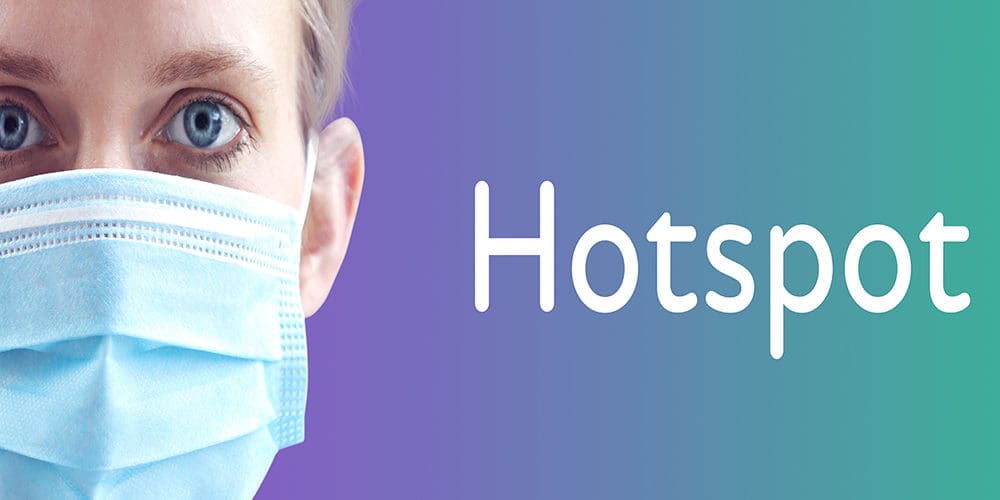Over 75% of COVID-19 Hotspots Are in College Towns
So far, more than 50,000 coronavirus cases in the U.S. have been linked to universities that brought students back to campus.

Although U.S. colleges continue to attempt to keep coronavirus outbreaks at bay, recent data suggests COVID-19 cases on college and university campuses are fueling the nation’s hottest outbreaks.
Universities that brought students back to campus have been linked to more than 50,000 infections, reports AXIOS. According to data collected by USA Today, of the 25 current worst outbreaks in the U.S., communities with a large number of college students represent 19 of them. The most severe is in Harrisonburg, Virginia, which is home to James Madison University. There are currently an estimated 1,562 cases per 100,000 people. The campus has an estimated enrollment of nearly 20,000 undergraduate students.
In Lafayette County, Mississippi, which is home to the University of Mississippi and currently fifth on the list of counties with the worst outbreaks, a June outbreak in the town of Oxford was tied to Greek life recruitment parties.
“I definitely feel a kind of heightened sense of COVID agoraphobia now that (undergraduate) students are back in town,” said Katie Turner, a doctoral student at UM.
In Story County, Iowa, home to Iowa State University and one of the country’s hottest outbreaks, an increase in cases among people 45 years and older shows the hotspot is spreading from campus, said Dr. John Paschen, the chair of the county’s health board.
“What I’m really afraid of is we’re going to have another episode where it gets into a nursing home and a lot of people die,” Paschen told USA Today.
Even in towns and cities that don’t currently have the most severe outbreaks, colleges and universities are taking drastic measures to try to stop the spread. Last week, the University of Miami announced it would start requiring that on-campus students get tested every two weeks for the remainder of the fall semester, reports The Miami Herald. The decision came after the school reported a 3.6% positivity rate as of Thursday.
At Michigan State University (MSU), which is in Ingham County, all students have been asked to quarantine for the next two weeks to contain the “exponential growth” of COVID-19 cases, county health officials said. An estimated 342 people associated with the East Lansing school have tested positive since August 24, according to ABC News. In the three weeks prior, there were only 23 cases.
Not surprisingly, the biggest culprit for the spread appears to be students attending parties or social gatherings, and not in-person classes, which many schools were afraid of. At least a third of the students who tested positive at MSU had recently attended a social gathering and at least a third of those people were associated with a fraternity or a sorority, according to the health department.
“This is an urgent situation,” Ingham County Health Officer Linda S. Vail said in a statement Saturday. “The exponential growth of COVID-19 cases must stop. I am concerned about the health and safety of the MSU community, and importantly, I am seriously concerned that unchecked transmission locally will affect the health and safety of all Ingham County residents.”
Through 11:59 p.m. on Sept. 26, students are advised to only attend in-person classes, labs and athletic training, and can leave their homes for work, food, medicine, medical care or other necessary supplies that aren’t available through delivery services.
At Miami University in Ohio, more than 1,100 students tested positive since mid-August. Over Labor Day weekend, students who tested positive and were required to quarantine were caught hosting a large house party, according to CBS News.
The Oxford Police Department went to break up the party, which violated capacity rules of no more than 10 people. When officers arrived, they ran one student’s license and saw a note on the computer that the student had tested positive just one week prior. When the officer asked how many other people at the party had the virus, the student replied, “They all do.”
At the University of Alabama, more than 630 students and three student organizations have received sanctions for violating the school’s COVID-19 regulations, according to Yahoo. Of those, 33 were issued notices which suspend the students “from campus while their conduct cases proceed through due process.”
“Student suspensions could range in length depending on the severity of the conduct,” the university said.
At Indiana University in Bloomington, administrators quarantined three-fourths of Greek houses on campus and suggested students vacate the remaining houses and find new places to live.
Some campuses with significant spikes in positive cases are also scrambling to create or acquire more quarantine and isolation space. The University of Tennessee, which had approximately 600 active cases as of last Monday and currently has more than 2,100 people in quarantine or self-isolation, secured an additional hotel to use as isolation space for students living on campus who test positive, reports CNN.
“We need more isolation spaces. This hotel is not going to be enough. And we are in the process of creating more isolation space on campus,” Chancellor Donde Plowman said during a live stream Tuesday.
The unfavorable trajectory for so many campuses across the country has led to some schools extending their virtual learning. The California State University System, which was one of the first to choose to cancel in-person classes for the Fall 2020 semester, announced Thursday that all 23 campuses will continue with coursework primarily delivered virtually for the academic term beginning January 2021.
“After extensive consultation with campus presidents and other stakeholders, and careful consideration of a multitude of factors – regarding the pandemic and its consequences, as well as other matters impacting the university and its operations – I am announcing that the CSU will continue with this primarily virtual instructional approach for the academic term that begins in January 2021, and also will continue with reduced populations in campus housing,” CSU Chancellor Timothy P. White wrote in a message to the campus community. “This decision is the only responsible one available to us at this time. And it is the only one that supports our twin North Stars of safeguarding the health, safety and well-being of our faculty, staff, students and communities, as well as enabling degree progression for the largest number of students.”
If you appreciated this article and want to receive more valuable industry content like this, click here to sign up for our FREE digital newsletters!
 Leading in Turbulent Times: Effective Campus Public Safety Leadership for the 21st Century
Leading in Turbulent Times: Effective Campus Public Safety Leadership for the 21st Century
This new webcast will discuss how campus public safety leaders can effectively incorporate Clery Act, Title IX, customer service, “helicopter” parents, emergency notification, town-gown relationships, brand management, Greek Life, student recruitment, faculty, and more into their roles and develop the necessary skills to successfully lead their departments. Register today to attend this free webcast!








